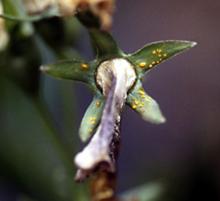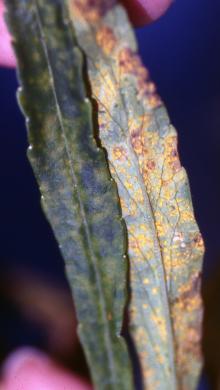By B. Warneke and J. Pschiedt.
Cause Coleosporium campanulae has been reported from BC and Puccinia campanulae has been reported from OR, WA and BC. These are rust fungi that are obligate biotrophs, requiring a living host on which to survive and reproduce. They do not kill their hosts but through severe infections can reduce growth and cause leaf drop, decreasing the cosmetic value of bellflower plantings. Coleosporium campanulae requires Bellflower (urediniospores and teliospores) and pine (Pinus spp., pycniospores and aceiospores) to complete its life cycle. Urediniospores are capable of secondary infection of uninfected plants and plant parts and can be disseminated by wind and rain over short to relatively long distances. Puccinia campanulae only requires Bellflower in order to survive and reproduce, with teliospores serving as the resting structure and basidiospores spreading the infection. Coleosporum campanulae has been reported in British Columbia and observed in Oregon while Puccinia campanulae has been reported in Oregon and Washington. Mild, moist conditions are most conducive to rust infection due to the spores' requirement of free water on the leaf in order for infection to take place.
Symptoms The first symptom generally observed is chlorotic leaf spots followed by the development of numerous orange-to-reddish-spore masses (pustules) on the underside of leaves. Pustules can also form on the top of leaves and stems. Pustules are made of plant cells that have ruptured due to excessive sub-epidermal production of urediniospores or teliospores. Teliospores produced by P. campanulae will usually appear more reddish-brown in color. Teliospores can be distinguished from urediniospores via light microscopy by their darker color and division into two cells by a septum.
Cultural control Prevention is the best control, but in many cases symptoms are observed after the disease has already spread.
- Inspect plants before purchasing for evidence of infection.
- Quarantine for 3 weeks before planting.
- Adequately space plants for better aeration and drying.
- Avoid overhead irrigation if possible.
- Separate from pine as far apart as possible.
- Remove and destroy infected plant parts.
Chemical control Chemical control is only possible if products are applied in a preventative manner. Commercial settings are generally the only cases that warrant chemical control.
- Compass 50 WDG at 2 to 4 oz/100 gal water. Do not use organosilicate additives. Group 11 fungicide. 12-hr reentry.
- Eagle 20 EW at 6 to 12 fl oz/100 gal water. Group 3 fungicide. 24-hr reentry.
- Myclobutanil 20 EW T&O at 6 to 12 fl oz/100 gal water plus spreading agent. May observe a PGR effect. Group 3 fungicide. 24-hr reentry.
- ProStar 70 WG at 3 to 6 oz/100 gal water. Test before using to be sure it is safe. Group 7 fungicide. 12-hr reentry.
Reference Ziller, W.G. 1974. The Tree Rusts of Western Canada. Service Publication 1329. Canadian Forestry


